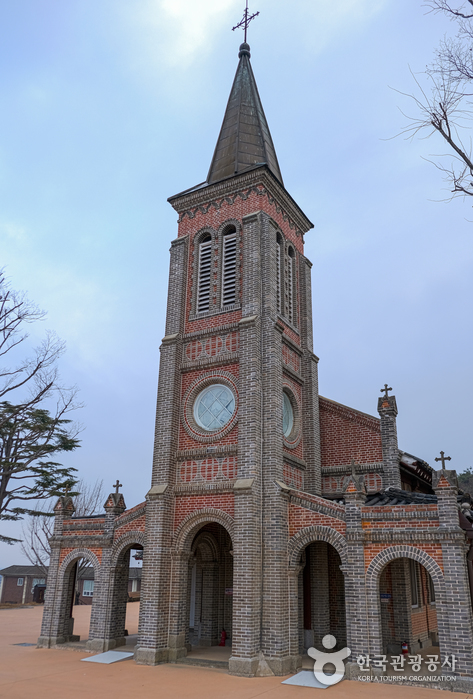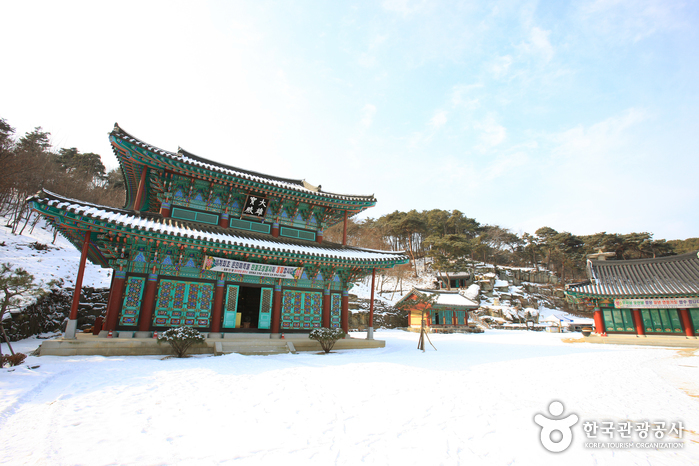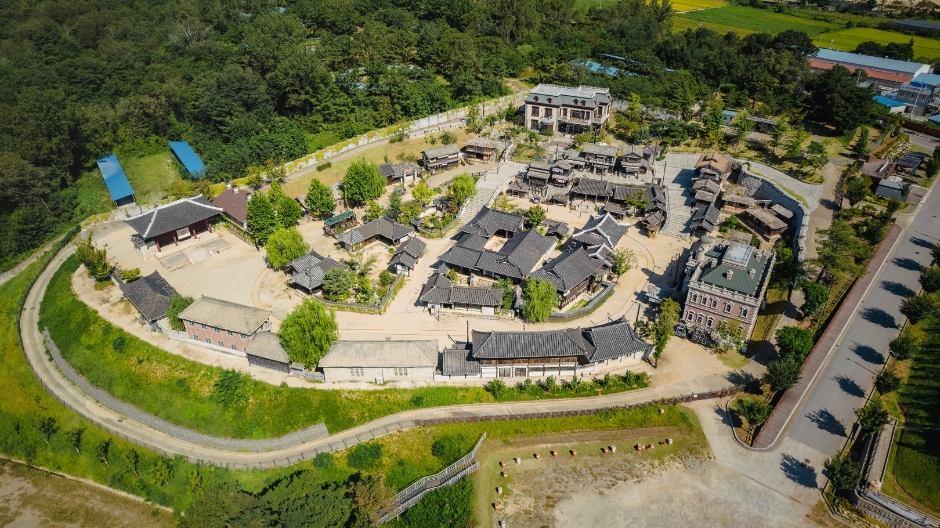Nabawi Catholic Church (화산천주교회(나바위 성당))
3.2Km 2024-04-07
146, Nabawi 1-gil, Iksan-si, Jeonbuk-do
+82-63-861-9210
Nabawi Catholic Church is located in Hwasan-ri, Mangseong-myeon in Iksan, Jeollabuk-do Province and is known as the oldest surviving catholic church in the Jeolla-do region. The church was built in 1906 to commemorate the return of priest Kim Dae-geon in 1845 (Joseon dynasty) after he was ordained in Shanghai, China. Inside the church stand two monuments: one built in 1954 to honor Joseph Vermorel (French missionary, 1860-1937) and one built in 1955 to honor priest and martyr Kim Dae-geon. Considered the most significant catholic relic of the Jeolla-do region, the church is sought out by large numbers of Catholic visitors each year.
Kim Jaesung Dunuchon (김재성두부촌)
7.0Km 2024-10-15
1F, 76 Buchang-ro, Nonsan-si, Chungcheongnam-do
041-735-2914
Kim Jaesung Dunuchon is a specialty restaurant where you can taste homemade bean curd dishes. They make bean curd using traditional methods with Korean soybeans, resulting in a smooth and savory flavor. Their bean curd is known for its tender texture and richness, especially when enjoyed with aged kimchi (fermented cabbage kimchi) matured for three years. Their menu includes dubuchon jeongsik (tricolor bean curd and boiled pork slices set menu), dubu bossam (napa wraps with pork and bean curd), dubu baekban (bean curd set menu), dubu duruchigi (stir-fried bean curd), and sogogi beoseot dubu jeongol (beef, mushroom and bean curd hot pot).
Himart - Nonsan Branch [Tax Refund Shop] (하이마트 논산점)
7.5Km 2024-04-19
395, Jungang-ro, Nonsan-si, Chungcheongnam-do
-
Homeplus - Nonsan Branch [Tax Refund Shop] (홈플러스 논산)
7.5Km 2024-04-18
187, Simin-ro, Nonsan-si, Chungcheongnam-do
-
Nonsan Strawberry Festival (논산딸기축제)
7.5Km 2025-07-09
270 Simin-ro, Nonsan-si, Chungcheongnam-do
+82-41-730-2973
The Nonsan Strawberry Festival is held in Nonsan, the largest strawberry production region in Korea. Its rich soil and clean water and air give the region a perfect environment for growing excellent quality strawberries. It has been making its mark as a strawberry producer for 90 years, including 50 of which had full-scale production and shipment. The festival here helps elevate the regional economy and also functions to establish better communication among cities. Also, the festival is thought of as one of the most well-known festivals in Chungcheongnam-do, attracting a lot of domestic and overseas visitors. It features a picnic zone with strawberries, a science experience kids zone for children’s enjoyment, and special content related to Nonsan’s defense-friendly identity, such as a helicopter tour.
Nonsan Gwanchoksa Temple (관촉사(논산))
8.9Km 2021-12-03
25, Gwanchok-ro 1beon-gil, Nonsan-si, Chungcheongnam-do
+82-41-736-5700
Gwanchoksa Temple in Nonsan, Chungcheongnam-do is located at the foot of Banyasan Mountain (100 meters in elevation). This temple enshrines a Seokjomireukbosalipsang Buddha (Treasure), which was built over the course of 38 years, beginning in 967 during the Goryeo period. According to legend, while a lady was picking fernbrake on Banyasan Mountain, she heard a baby crying. When she went over, there was no baby but instead was a large rock sticking out from the ground. Upon hearing this story, the government ordered a Buddha statue to be made from the rock. This Buddha statue, widely known as ‘Eunjimireuk Buddha,’ is the largest stone Buddha in Korea (18.12 meters in x_height, 9.9 meters in girth, 1.8 meters in the length of ears, 2.43 meters at the x_height of crown). There are many other cultural heritages in this temple and every April, a splendid cherry blossom tunnel stretching from Nonsan to Gwanchoksa Temple is at its peak.
Sunshine Studio (논산 선샤인스튜디오)
10.1Km 2025-10-24
90 Bonghwang-ro, Yeonmu-eup, Nonsan-si, Chungcheongnam-do
Originally established as the set for the drama "Mr. Sunshine", it has since garnered interest as a filming location for historical dramas such as "Pachinko" and "Tale of the Nine Tailed 1938". It is currently open to the public as a tourist attraction. Strolling through Sunshine Studio in costumes of the era, one feels as if they've stepped into the bustling Hanseong of the 1900s.
Sunshine Land (선샤인랜드)
10.3Km 2024-07-09
102 Bonghwang-ro, Yeonmu-eup, Nonsan-si, Chungcheongnam-do
Sunshine Land is a cultural complex located in Nonsan, Chungcheongnam-do. One can experience and observe diverse content at this themed attraction, which is divided into four sections: Survival Experience Center, Military Experience Center, Sunshine Studio, and 1950 Studio. The Survival Experience Center and Military Experience Center incorporate VR technology for an interactive and realistic entertainment. The Sunshine Studo and 1950 Studio are decorated in the theme of the aftermath of the Korean War, allowing one to get a glimpse and knowledge of what life in Korea was like after the war.
Buyeo Garimseong Fortress (부여 가림성)
11.2Km 2025-10-23
167 Seongheung-ro 97beon-gil, Imcheon-myeon, Buyeo-gun, Chungcheongnam-do
+82-41-830-2880
Garimseong Fortress is a stone fortress built on the lower reaches of the Geumgang River to protect Sabiseong Fortress, the capital of the Baekje dynasty. The fortress' parking lot is only 200 meters away from the southern entrance, allowing visitors to easily access and enjoy the view from this historical fortress. By ascending the stairway by the rocky cliff, a large tree comes into view. Known to be over 400 years old, this tree is called the "Love tree of Seongheungsan Mountain" and has even made an appearance in the drama "Seodongyo (200)." The fortress is also popular as a sunrise spot, serving as Buyeo-gun’s New Year's Eve festival venue.
◎ Travel information to meet Hallyu’s charm - TV series "Hotel Del Luna"
From Man-wol’s friendship with Yeon-woo to her anger toward Chung-myung in “Hotel Del Luna,” Buyeo Garimseong Fortress has become a popular social media hotspot. Offering a panoramic view of Buyeo’s cityscape, the fortress became a new social media hotspot as it offers a unique photo opportunity under a zelkova tree called the “love tree.”
Buyeo Naseong Fortress [UNESCO World Heritage] (부여 나성 [유네스코 세계문화유산])
12.6Km 2021-07-22
100-11, Dongmun-ro142beon-gil, Buyeo-gun, Chungcheongnam-do
+82-41-830-2623
Buyeo Naseong, also known as the Outer City Wall, was built to protect the capital of Baekje, Sabi. It has a x_height of about 8.4 kilometers. The wall surrouned Busosanseong Fortress and extended to the city of Buyeo.
The wall is one of the oldest walls along with Naseong in Pyeongyang and it is estimated to have been built around 538, when the Baekje capital was changed from Woonjin (current Gongju) to Sabi (current Buyeo). The wall of the fortress starts from the site where Dongmun (East gate) was located to the area of Geumgang River, made by piling soil up. However, only a few traces remain of its former glory.
For now, it leaves a blurry trail including a 20 meter area to the east of Cheongsanseong Fortress, Dongmun Bridge from Seokmok-ri, and an area from Pilseobong Peak to Yeomchang-ri. While the outer wall is sharply sloped, the inner wall was built with a gentle slope to make it easier for horses to reach the guard posts on the top of the wall. Inside the fortress, the palace of Baekje, government offices, houses, temples, stores and protected facilities can be seen. The entire structure of Naseong Fortress features Geumgang River in the south and west sides, providing a natural double-defense system. The wall was one of the important outer defense facilities along with Cheongsanseong and Cheongmasanseong Fortresses.
* Area: 554,591 ㎡

![Himart - Nonsan Branch [Tax Refund Shop] (하이마트 논산점)](http://tong.visitkorea.or.kr/cms/resource/45/2883345_image2_1.jpg)
![Homeplus - Nonsan Branch [Tax Refund Shop] (홈플러스 논산)](http://tong.visitkorea.or.kr/cms/resource/46/2883346_image2_1.jpg)





![Buyeo Naseong Fortress [UNESCO World Heritage] (부여 나성 [유네스코 세계문화유산])](http://tong.visitkorea.or.kr/cms/resource/71/2725771_image2_1.jpg)
 English
English
 한국어
한국어 日本語
日本語 中文(简体)
中文(简体) Deutsch
Deutsch Français
Français Español
Español Русский
Русский